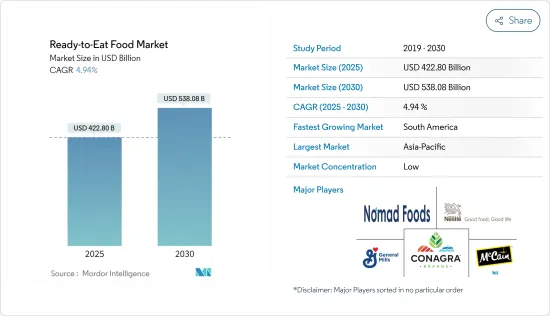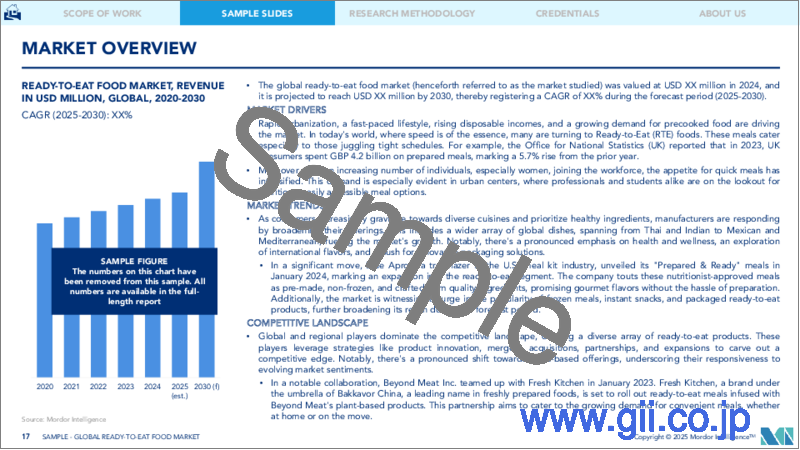|
|
市場調査レポート
商品コード
1686601
RTE食品:市場シェア分析、産業動向・統計、成長予測(2025年~2030年)Ready-to-Eat Food - Market Share Analysis, Industry Trends & Statistics, Growth Forecasts (2025 - 2030) |
||||||
カスタマイズ可能
適宜更新あり
|
|||||||
| RTE食品:市場シェア分析、産業動向・統計、成長予測(2025年~2030年) |
|
出版日: 2025年03月18日
発行: Mordor Intelligence
ページ情報: 英文 150 Pages
納期: 2~3営業日
|
全表示
- 概要
- 目次
2025年のRTE食品市場規模は4,228億米ドルと推定され、予測期間(2025-2030年)のCAGRは4.94%で、2030年には5,380億8,000万米ドルに達すると予測されます。

主なハイライト
- 社会人の多忙なライフスタイルや多忙な仕事のスケジュールにより、消費者の嗜好が家庭料理から調理済み製品へとシフトしています。このような消費者行動の変化は、予測期間中の市場研究を大きく押し上げると思われます。調理済み製品は、いつでも(朝食、昼食、夕食など)食べることができる、通常の食品に最も近い代替品と考えられています。
- 新製品や新素材に対する消費者の関心は高まっており、今後も積極的な開発が見込まれます。伝統的な料理だけでなく、消費者はインド料理、タイ料理、イタリア料理など、他の民族のさまざまな食事を試してみたいと思っています。そのため、エスニックなRTE食品への嗜好が、こうした製品の需要を牽引しています。
- ミレニアル世代や若い世代は、収入の大半をこうした食品に費やすため、RTE食品製造大手にとって最も簡単なターゲットです。したがって、こうした製品の利便性が世界市場の総需要を増大させています。さらに、消費者の健康意識の高まり、生活習慣病の優位性、生鮮食品に関連する栄養価が、RTE食品市場を抑制しています。
RTE食品市場の動向
便利でヘルシーなインスタント食品に対する需要の急増
- 世界的に、便利でインスタント食品、特にインスタント・パスタ、米、スナック菓子、肉製品などの需要は、社会的・経済的パターンの変化、飲食料品への支出増加、健康食品に対する意識、食事パターンや既存の食習慣の変化、世界各地での外国人定住人口の増加、新製品を味わいたいという欲求などにより、速いペースで伸びています。
- 米国はRTE食品の世界最大市場のひとつであり、ドイツや英国などがこれに続いているほか、アジア太平洋、中東、ラテンアメリカの新興市場も同様に今後の成長が見込まれています。
- 特に労働者階級の人々、10代の子供たち、ホステル暮らしの人々、多忙なライフスタイルを送る独身者たちの間で、インスタントや簡単に調理できる間食や惣菜が大人気となっています。さらに、オン・ザ・ゴーのコンセプトは、RTE食品が提供できる製品の簡単な消費と取り扱いと密接に結びついています。このように、消費と同時に使い捨て包装に助けられた利便性の連動により、RTE食品の需要は増加しています。
- 例えば、米国の食品会社ゼネラル・ミルズは2021年3月、同社の製パン・ブランドであるピルズベリーをベースとした調理済みクッキーを初めて発売しました。ピルズベリーのソフトベイクド・クッキーは、チョコレートチップ、霧吹きアイシング入りコンフェティシュガー、ショコラドリズル入りピーナッツバターの4種類のフレーバーで発売されます。
アジア太平洋が市場を独占
- アジア太平洋地域はRTE食品市場を独占しています。冷凍肉製品、ピザなどの冷凍スナック、冷凍シリアル、スープなどの冷凍RTE食品に対する需要の高まりが市場を牽引しています。よりエキゾチックな製品の導入、プライベート・ブランドの流入、製品のプレミアム化などが市場の需要を支える要因となっています。惣菜に対する消費者の認識は持続的に改善しており、利便性と調理時間の短さは消費者にとって理想的です。
- 中国やインドなどの国々は、力強い成長と高い潜在力により、この地域の需要をリードしていくと思われます。チルドRTE食品と冷凍RTE食品は、これらの国々で最も消費されているRTE食品のカテゴリーでもあります。グルテンフリー、ビーガン、持続可能なパッケージングなど、消費者の食の嗜好の進化が市場に付加価値を与えています。
- 例えば、2022年2月、VegaBytz社は植物由来の100%ビーガン食肉製品をインドで発売しました。VegaBytzの製品ラインでは、肉/鶏肉/ツナの調理済み食事とカレー製品はすべてビーガンで、すべて植物から作られています。さらに、同市場で事業を展開する企業は、これらの国々で強固な足場を築くための戦略的施策の導入に注力しており、市場成長を牽引しています。
RTE食品産業の概要
世界のRTE食品市場は競争が激しく、Nomad Foods Ltd、General Mills、McCain Foods、Nestle SA、Conagra Brandsなどの主要企業が市場に進出しています。産業の収益性が高いことから、メーカーは強力な競争戦略を展開し、既存の市場プレーヤー間の競争を激化させています。主要市場プレーヤーは、市場での競争力を維持するための主要戦略の一環として、製品革新、製品発売、M&A、地理的拡大などに取り組んでいます。また、企業は市場での競争優位性を獲得するために、製品の提供、品質、味、風味、価格、機能性、サイズ、パッケージング、マーケティング活動など、さまざまな要因で自社製品を位置づけています。
その他の特典:
- エクセル形式の市場予測(ME)シート
- 3ヶ月間のアナリスト・サポート
目次
第1章 イントロダクション
- 調査の前提条件と市場定義
- 調査範囲
第2章 調査手法
第3章 エグゼクティブサマリー
第4章 市場力学
- 市場促進要因
- 市場抑制要因
- ポーターのファイブフォース分析
- 新規参入業者の脅威
- 買い手・消費者の交渉力
- 供給企業の交渉力
- 代替品の脅威
- 競争企業間の敵対関係の強さ
第5章 市場セグメンテーション
- 製品タイプ
- インスタント朝食/シリアル
- インスタントスープとスナック
- レディミール
- 焼き菓子
- 肉製品
- その他の製品タイプ
- 流通チャネル
- ハイパーマーケット・スーパーマーケット
- コンビニエンスストア
- オンラインストア
- その他の流通チャネル
- 地域
- 北米
- 米国
- カナダ
- メキシコ
- その他北米地域
- 欧州
- スペイン
- 英国
- ドイツ
- フランス
- イタリア
- ロシア
- その他欧州
- アジア太平洋
- 中国
- 日本
- インド
- オーストラリア
- その他アジア太平洋地域
- 南米
- ブラジル
- アルゼンチン
- その他南米
- 中東・アフリカ
- 南アフリカ
- サウジアラビア
- その他中東とアフリカ
- 北米
第6章 競合情勢
- 最も採用されている戦略
- 市場シェア分析
- 企業プロファイル
- Nomad Foods Ltd
- General Mills, Inc.
- McCain Foods Limited
- Nestle S.A.
- Premier Foods Group Limited
- Conagra Brands, Inc.
- Amy's Kitchen
- Dr. August Oetker Nahrungsmittel KG
- Campbell Soup Company
- The Kraft Heinz Company
第7章 市場機会と今後の動向
The Ready-to-Eat Food Market size is estimated at USD 422.80 billion in 2025, and is expected to reach USD 538.08 billion by 2030, at a CAGR of 4.94% during the forecast period (2025-2030).

Key Highlights
- The market is witnessing a shift in consumer preferences from home-cooked food to ready-to-eat products, owing to working individuals' busy lifestyles and hectic work schedules. This change in consumer behavior will likely uplift the market studied significantly in the forecast period. Ready-to-eat products are considered the closest alternative to regular food, which can be consumed at any time (such as during breakfast, lunch, or dinner).
- Consumer interest in new products and ingredients is rising and is expected to witness positive developments. Besides traditional cuisine, consumers are eager to try different meals from other ethnicities, such as Indian, Thai, and Italian. Therefore, preference for ethnic ready-to-eat food has driven the demand for these products.
- Millennials and the young generation are the easiest targets for ready-to-eat food manufacturing giants as they spend most of their income on such food products. Thus, such products' convenience level is increasing the global market's total demand. Furthermore, the rising health consciousness among consumers, the predominance of lifestyle disorders, and the nutritional value associated with fresh food are restraining the ready-to-eat food products markets.
Ready to Eat Food Market Trends
Surge in Demand for Convenient and Healthy Instant Food
- Globally, the demand for convenient and instant food, particularly instant pasta, rice, snacks, meat products, and others, is growing at a faster pace due to changes in social and economic patterns, as well as increased expenditure on food and beverage, awareness about healthy foods, changes in meal patterns and existing food habits, growing ex-pat settlement population around the world and the desire to taste new products.
- The United States is one of the world's largest markets for ready-to-eat food, with countries like Germany and the United Kingdom following suit, and the emerging markets of Asia-Pacific, the Middle East, and Latin America are too projected to see future growth for the same.
- Instant or easy-to-prepare snacking and ready meals are becoming extremely popular, especially among working-class people, teenage children, people living in hostels, and bachelors due to their hectic lifestyles. Moreover, the on-the-go concept is closely associated with easy consumption and handling of products, which ready-to-eat food can offer. Thus, the demand for ready-to-eat food is increasing due to the linked convenience of consumption and aided by disposable packaging simultaneously.
- For instance, in March 2021, General Mills, United States food company, released ready-to-eat cookies based on its baking brand Pillsbury for the first time. Pillsbury's Soft Baked Cookies will be available in four flavors: chocolate chip, confetti sugar with drizzled icing, and peanut butter with chocolatey drizzle.
Asia-Pacific Dominates the Market
- Asia-Pacific dominates the ready-to-eat food market. The rising demand for frozen and ready meals, such as frozen meat products, and frozen snacks like pizza, frozen cereals, soups, etc., drive the market. The introduction of more exotic products, the influx of private labels, and product premiumization are some factors supporting market demand. The consumers' perception of ready meals is persistently improving, where convenience and high-speed cooking time is ideal for consumers.
- Countries such as China and India are likely to lead the demand in the region due to strong growth and high potential in these countries. Chilled ready meals and frozen ready meals are also one of the most consumed categories of ready-to-eat food in these countries. Evolving consumer food preferences such as gluten-free, vegan, and sustainable packaging add value to the market.
- For instance, in February 2022, VegaBytz introduced their plant-based, 100% vegan meat products in India. Meat/Chicken/Tuna ready-to-eat meals and curry products are all vegan and made entirely from plants in the VegaBytz product line. In addition, companies operating in the market are focusing on adopting strategic measures to achieve a strong foothold in these countries, driving the market growth.
Ready to Eat Food Industry Overview
The global ready-to-eat food market is highly competitive, with the presence of key players operating in the market, such as Nomad Foods Ltd, General Mills, McCain Foods, Nestle SA, and Conagra Brands, among others. High industrial profitability has led manufacturers to develop powerful competitive strategies, intensifying competition among the existing market players. Major market players are undertaking product innovation, product launches, mergers and acquisitions, geographic expansion, etc., as part of key strategies to remain competitive in the market. Companies are also positioning their products on different factors, including product offerings, quality, taste, flavors, price, functionality, size, packaging, and marketing activities, to gain a competitive advantage in the market.
Additional Benefits:
- The market estimate (ME) sheet in Excel format
- 3 months of analyst support
TABLE OF CONTENTS
1 INTRODUCTION
- 1.1 Study Assumptions and Market Definition
- 1.2 Scope of the Study
2 RESEARCH METHODOLOGY
3 EXECUTIVE SUMMARY
4 MARKET DYNAMICS
- 4.1 Market Drivers
- 4.2 Market Restraints
- 4.3 Porter's Five Forces Analysis
- 4.3.1 Threat of New Entrants
- 4.3.2 Bargaining Power of Buyers/Consumers
- 4.3.3 Bargaining Power of Suppliers
- 4.3.4 Threat of Substitute Products
- 4.3.5 Intensity of Competitive Rivalry
5 MARKET SEGMENTATION
- 5.1 Product Type
- 5.1.1 Instant Breakfast/Cereals
- 5.1.2 Instant Soups and Snacks
- 5.1.3 Ready Meals
- 5.1.4 Baked Goods
- 5.1.5 Meat Products
- 5.1.6 Other Product Types
- 5.2 Distribution Channel
- 5.2.1 Hypermarkets/Supermarkets
- 5.2.2 Convenience Stores
- 5.2.3 Online Retail Stores
- 5.2.4 Other Distribution Channels
- 5.3 Geography
- 5.3.1 North America
- 5.3.1.1 United States
- 5.3.1.2 Canada
- 5.3.1.3 Mexico
- 5.3.1.4 Rest of North America
- 5.3.2 Europe
- 5.3.2.1 Spain
- 5.3.2.2 United Kingdom
- 5.3.2.3 Germany
- 5.3.2.4 France
- 5.3.2.5 Italy
- 5.3.2.6 Russia
- 5.3.2.7 Rest of Europe
- 5.3.3 Asia-Pacific
- 5.3.3.1 China
- 5.3.3.2 Japan
- 5.3.3.3 India
- 5.3.3.4 Australia
- 5.3.3.5 Rest of Asia-Pacific
- 5.3.4 South America
- 5.3.4.1 Brazil
- 5.3.4.2 Argentina
- 5.3.4.3 Rest of South America
- 5.3.5 Middle-East and Africa
- 5.3.5.1 South Africa
- 5.3.5.2 Saudi Arabia
- 5.3.5.3 Rest of Middle-East and Africa
- 5.3.1 North America
6 COMPETITIVE LANDSCAPE
- 6.1 Most Adopted Strategies
- 6.2 Market Share Analysis
- 6.3 Company Profiles
- 6.3.1 Nomad Foods Ltd
- 6.3.2 General Mills, Inc.
- 6.3.3 McCain Foods Limited
- 6.3.4 Nestle S.A.
- 6.3.5 Premier Foods Group Limited
- 6.3.6 Conagra Brands, Inc.
- 6.3.7 Amy's Kitchen
- 6.3.8 Dr. August Oetker Nahrungsmittel KG
- 6.3.9 Campbell Soup Company
- 6.3.10 The Kraft Heinz Company






